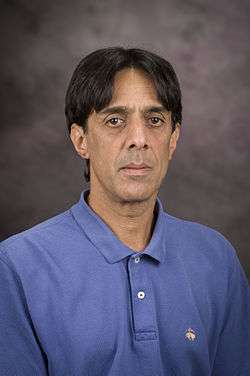Bharat Ratra
Bharat Vishnu Ratra (born 26 January 1960) is an Indian-American physicist and theoretical cosmologist and astroparticle physicist who is currently a university distinguished professor of Physics at Kansas State University.[1]
Bharat Vishnu Ratra | |
|---|---|
 | |
| Born | 26 January 1960 Bombay (Mumbai), India |
| Alma mater | Indian Institute of Technology Delhi (MS) Stanford University (PhD) |
| Known for | Quintessence (physics) Dark energy |
| Scientific career | |
| Fields | Theoretical physics Physical cosmology Astroparticle physics |
| Institutions | Kansas State University Massachusetts Institute of Technology California Institute of Technology Princeton University Stanford University |
| Doctoral advisor | Leonard Susskind Michael Peskin |
He is known for his work on dynamical dark energy and on the quantum-mechanical generation of energy density and magnetic field fluctuations during inflation.
Biography
Ratra was born in Bombay (Mumbai). He graduated with a Master of Science in physics from the Indian Institute of Technology Delhi in 1982 and completed his doctorate in physics at Stanford University in 1986 under the supervision of Leonard Susskind and Michael Peskin.
Ratra was a postdoctoral fellow at the Stanford Linear Accelerator Center, Princeton University, the California Institute of Technology and the Massachusetts Institute of Technology. He joined Kansas State University in 1996 as an assistant professor of physics. He was promoted to associate professor in 2001 and professor in 2004.
Academics and research
Ratra has worked in a number of areas of cosmology and astroparticle and early universe physics.
In 1988, Ratra and Jim Peebles of Princeton University proposed the first dynamical dark energy scalar field, or quintessence, model.[2][3] Dark energy is the leading candidate for the mechanism that is responsible for causing the observed accelerated cosmological expansion.[4][5]
Ratra and his students and collaborators have pioneered measurements of the redshift of the transition between an earlier epoch when cosmological expansion decelerated because dark and baryonic (ordinary) matter dominated the cosmological energy budget and the current epoch where the cosmological expansion accelerates because dark energy dominates the current cosmological energy budget.[6][7]
Ratra's early universe research includes the first consistent semi-classical computation of the spectrum of energy density perturbations from inflation. He collaborated with Willy Fischler of the University of Texas at Austin and Leonard Susskind of Stanford University on this computation.[8][9]
Ratra also proposed the first inflation model that can generate, from quantum fluctuations, a large-enough primordial cosmological magnetic field to be able to explain observed galactic magnetic fields.[10]
Honours
- National Science Foundation CAREER award (1999)
- Fellow of the American Physical Society (2002)
- Fellow of the American Association for the Advancement of Science (2005)
- Olin Petefish Award in Basic Science (2017)
References
- "Department of Physics". ksu.edu.
- P. J. E. Peebles and B. Ratra, "Cosmology with a time-variable cosmological 'constant'", Astrophys. J. 325, L17 (1988) (PDF)
- B. Ratra and P. J. E. Peebles, "Cosmological consequences of a rolling homogeneous scalar field", Phys. Rev. D 37, 3406 (1988)
- P. J. E. Peebles and B. Ratra, "The cosmological constant and dark energy", Rev. Mod. Phys. 75, 559 (2003)
- * B. Ratra and M. S. Vogeley, "The beginning and evolution of the universe", Pub. Astron. Soc. Pacific 120, 235 (2008)
- O. Farooq and B. Ratra, "Hubble parameter measurement constraints on the cosmological deceleration-acceleration transition redshift", Astrophys. J. 766, L7 (2013)
- O. Farooq, F. R. Madiyar, S. Crandall and B. Ratra, Astrophys. J. 835, 26 (2017)
- W. Fischler, B. Ratra and L. Susskind, "Quantum mechanics of inflation", Nucl. Phys. B 259, 730 (1985)
- B. Ratra, "Restoration of spontaneously broken continuous symmetries in de Sitter spacetime", Phys. Rev. D 31, 1931 (1985) (PDF)
- B. Ratra, "Cosmological `seed' magnetic field from inflation", Astrophys. J. 391, L1 (1992) (PDF)
External Links
| Wikiquote has quotations related to: Bharat Ratra |
- 13 February 2017 University of Kansas Colloquium: Dark Energy: constant or time variable? (... and other open questions)
- 5 November 2019 Kansas State University Colloquium: The Accelerating Expanding Universe: Dark Matter, Dark Energy, and Einstein's Cosmological Constant, or Why Jim Peebles was Awarded Half of the 2019 Physics Nobel Prize